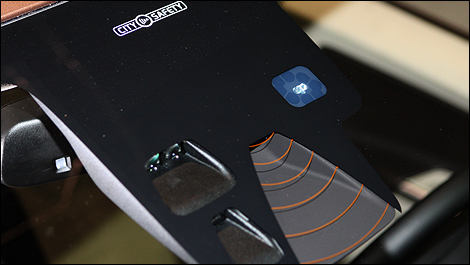Imagine yourself moving slowly through rush-hour traffic. As you drive, you drip some coffee on your lap and look away for just a short moment. At the same time, the car suddenly stops in front of you. Bang!
A moment's inattention is all it takes to cause an accident.
In fact Volvo research has demonstrated that 75% of all collisions occur below 30 km/h. And in half of the cases, drivers are simply distracted and fail to brake in time.
Volvo developed the
City Safety system to reduce the impacts of a low-speed collision, be it serious injuries, such as whiplash syndrome, or vehicle damages. And currently, this system is exclusive to the
new XC60 compact crossover due out on the Canadian market in the Spring of 2009.
Laser driven"City Safety uses a laser sensor located behind the windshield next to the rear-view mirror", said Michel St-Hilaire, Volvo Canada Training, Customer Relations and CSI Manager, at a demonstration Auto123.com attended in Montreal, Quebec. "It can detect vehicles or large objects up to 10 metres in front of the XC60's front bumper, with the help of a computer capable of making 50 calculations per second.
 |
| City Safety uses a laser sensor located behind the windshield next to the rear-view mirror to detect vehicles or large objects up to 10 metres in front of the XC60's front bumper. |
At speeds between 15 and 30 km/h, this system can react to vehicles that are either at a standstill or are moving slowly in the same direction as the car itself, by progressively slowing down the vehicle.
If the gap between the cars continues to close and the driver remains inactive, this system applies the brakes automatically to stop the XC60 and maintains the braking for almost two seconds.
On 24 hours a day!City
Safety works like a scout: in daylight as well as in darkness, it's always ready! However, since it's an optical technology, the laser sensor does have its limits.
For instance, its detection ability can be impaired by fog, snow or heavy rain. For it to be 100% effective, it is imperative that the windshield not be obstructed.
The sensor viewing area is cleaned by the windshield wipers. But when fine rain or light snow is falling, drivers who don't use the wipers often enough will reduce the effectiveness of the system.
In addition, the system doesn't discharge drivers from their responsibilities, which consist, among others, of maintaining a safe distance between their vehicle and the next one at all times.
After all, even this vehicle still needs to be driven by somebody!
Photo Credit : Philippe Champoux
